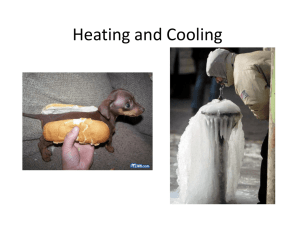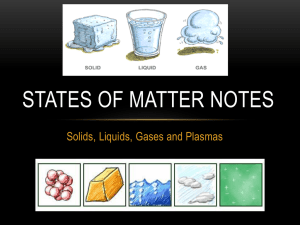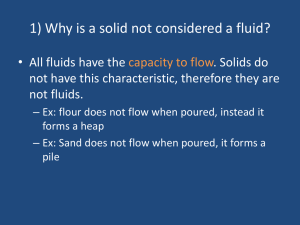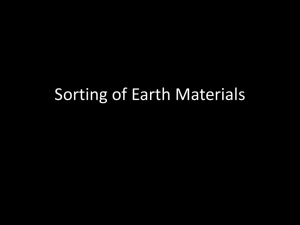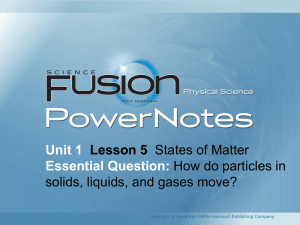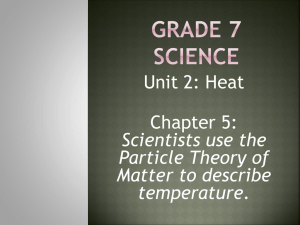Three States of Matter - Red Hook Central School District
advertisement
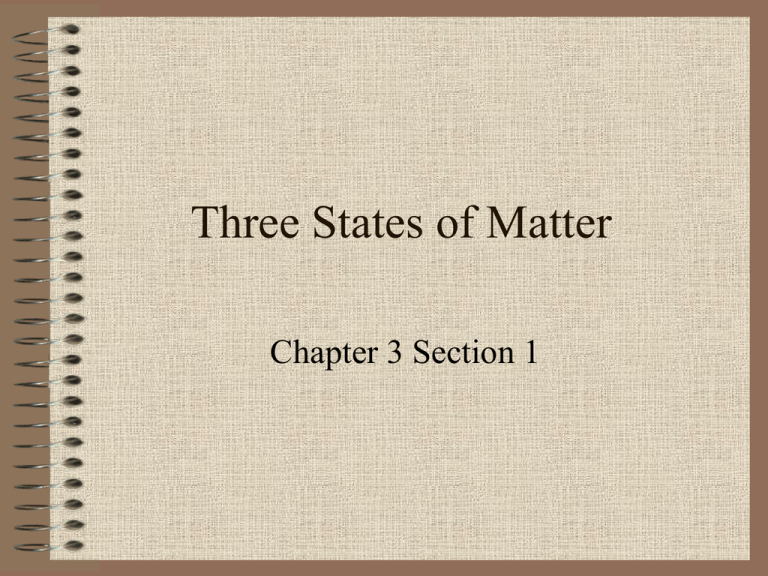
Three States of Matter Chapter 3 Section 1 Particles of Matter • The states of matter are the physical forms in which a substance can exist. • The three most familiar states are solid, liquid, and gas. (Plasma is the 4th state.) • Matter is made of tiny particles called atoms and molecules which are always in motion. • The way these particles interact helps determine the state of the matter. Figure 1, Page 66 • Figure 1 on page 66 describes the three familiar states of matter in terms of the speed and attraction of the particles. • Solids – molecules are highly attracted to each other and vibrate • Liquids – molecules are close and slide past each other • Gas – little attraction because a lot of motion Solids • Solid – the state in which the substance has a definite shape and volume • The attraction between particles is stronger than the particles of the same substance in the liquid or gaseous state. • Particles in a solid move, but only vibrate in their place. Types of Solids • Crystalline solid – have a very orderly, 3-D arrangement of particles; particles repeat in a pattern • Examples of crystalline solids are iron, diamond, and ice. • Amorphous solid – particles do not have a particular arrangement; substance can change shape under certain conditions • Examples of amorphous solids are glass, rubber, and wax. Liquids • Liquid – the state in which the substance has a definite volume but no definite shape • Particles move fast enough to overcome some of the attraction between them. • Molecules slide past each other to take the shape of the container. • The shape of a liquid can change, but the volume cannot. Characteristics of Liquids • Surface Tension – a force that acts on the particles at the surface of a liquid • Surface tension causes some liquids to form spherical drops and is different in different types of liquids. • Viscosity – a liquid’s resistance to flow • The stronger the attraction between the molecules of a liquid, the more viscous the liquid is. Gases • Gas – the state of matter that has no definite shape or volume. • Particles of a gas move quickly so there is less attraction between the particles. • The amount of empty space between gas particles can change depending on the container the gas is in. Behavior of Gases Chapter 3 Section 2 Temperature • Temperature is a measure of how fast the particles in an object are moving. • The faster the particles are moving the more energy they have. • On a hot day, gas particles move faster than on a cold day. Therefore, there is more pressure on the walls of the container holding the gas when the temperature is high. Temperature • Less gas is needed to fill a balloon in warm temperatures because the particles of the gas have more energy. • At cool temperatures particles move slower. • To fill a balloon in cool temperatures more gas is needed because the particles of the gas have less energy. Temperature • As external temperatures increase, the gases in a balloon expand and the balloon could pop. • When external temperatures decrease, the gases in a balloon condense and the balloon shrinks. Volume • Volume is the amount of space an object takes up. • Particles of gas spread out, so the volume of a gas depends on the container the gas is in. • Intro to PVT gases Pressure • The amount of force exerted on a given area of surface is pressure. • The basketball and beach ball in Figure 2 on page 71 hold the same volume of air. • There are more particles inside the basketball colliding with the inside surface of the ball. • There is more pressure in the basketball. Gas Behavior Laws • The temperature, pressure, and volume of a gas are linked. • Changing one of these factors will change the other two. • Gas laws describe the relationships between temperature, pressure, and volume. Boyle’s Law • Boyle’s Law states that for a fixed amount of gas at a constant temperature, the volume of the gas is inversely related to pressure. • As the pressure of a gas increases, the volume decreases by the same amount. Charles’s Law • Charles’s Law states that for a fixed amount of gas at a constant pressure, the volume of the gas changes in the same ways that the temperature of the gas changes. • Decreasing the temperature of the gas causes the volume of the gas to decrease. • Increasing the temperature of the gas causes the volume of the gas to increase.



